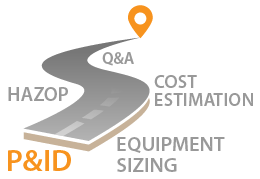
Recently I came across an announcement of a webinar on intelligent P&ID software I once used nearly 12 years ago. How bewildered I was to know after reading in-depth overview that no eye-catching smart feature has been added since then.
Today, in a knowledge sharing economy, putting "intelligent" label on a stagnant product is a sure way to bury it forever.
You may argue that P&ID is a core of process engineering discipline where the "change" word has entirely different meaning. I have bad news for apologists of process engineering purity. Digital Age breaks the partitions between disciplines, retarding the P&ID intelligence growth and ours as well.
How can we define the initial requirements for the P&ID software targeting Artificial Intelligence (AI) much talked about today? Requirements that should transform P&ID into AI powerhouse and knowledge-sharing platform, that should bail the project out of an imminent failure, and make the career growth of an engineer unlimited?
I start from first 20 points long overdue.
- P&ID shall be internet centered to reap huge benefits of concurrent virtual engineering. To match the different devices, P&ID shall replace "A-format-paper" thinking for equipment-module-boundary one. P&ID images shall not lose their quality when scaled down by at least 30%.
- Concurrent engineering requires that P&ID shall handle mix of different flavors of information in the same P&ID – "for information", "for construction" or "as built". It is natural as the P&ID items have different lead times. For instance, metal piping and valves have a lead time up to 4 months, big pumps – up to 12-14 months. Inability to do this raises the updates quantity by a factor of 4.
- P&ID shall store all the process information including thermodynamic properties for all design and off-design points of the plant operation. Match between the properties and specifications of the interlinked items shall be auto-validated.
- P&ID shall store all the information about the item used for its procurement. This point clears up the road to the open tendering offering much lower equipment prices.
- P&ID shall store all the control information needed for compiling operational sequences book: control narratives, alarms, interlocks, control loops and PID controller settings, item and module states and events.
- Instrumentation stored properties shall be extended to alarm deadbands, scan rates, process safety times and data acquisition directives.
- P&ID tag management shall be in the background, completely hidden from the user. It shall allow global tags editing and re-arrangement.
- P&ID shall be intuitive and responsive. Depending on the engineer duties it should show different layers of information: process, mechanical, control, or electrical. Information hiding shall be a guiding principle as the P&ID stakeholders require different level of information details.
- P&ID graphics shall be stripped of all "digitizable" pieces by moving to higher level of information abstraction. It includes such concepts as item aggregation and stacking, recurring item patterns, symbol overloading and overwriting, and item grouping that may be expanded or contracted. Symbol overloading and overwriting allow integration of P&IDs from different engineering services providers without re-drafting them.
- P&ID shall allow bi-directional navigation between PFD, plant layout and P&ID.
- There should be possibility to add annotations, question and answers. They shall be anchored to P&ID item or P&ID area, P&ID block, alarm, or control loop.
- P&ID shall allow messaging targeting any P&ID item or a group of items.
- The concepts of PLM - product lifecycle management - shall be extended to P&ID. Approval mechanism shall be built into P&ID and the whole project.
- P&ID shall provide the project metrics: engineering hours spent, item status, approvals status, fluid - material compatibility matrix, etc.
- P&ID shall include project-wide item search engine. It shall be easily extended with customized filters.
- Documents like images, drawings, product catalogs, sketches shall be anchored to P&IDs and items.
- P&ID software shall be driven by rule-based engineering. A rule is a guiding statement valid for all P&IDs and projects. A rule is created only once, but applied multiple times automatically. The primary source of rules is international and corporate standards and industry practices.
- Like MS WORD, P&ID shall have Copy, Paste, Scale, Autocomplete, Global Update, and "Grammar check" algorithms. They will boost quality and speed of project execution by 10 -100 times and let Artificial Intelligence (AI) into Process Engineering.
- P&ID data validation mechanism shall be 3-stage process: the software suggests, the user modifies, the software checks.
- P&ID shall easily accommodate the legacy P&ID images.
All listed requirements are already implemented by Crenger.com P&ID as part of the digital infrastructure for engineering services providers specializing in water treatment and desalination plants (EPC, BOO, BOOT).
Pragmatic question is can we convert all this intelligence into real revenues? Crenger experience shows that smart platforms provide much better engineering and management solutions leading to not less than 7% reduction in the desalination plants CAPEX. For 600 MLD SWRO plant tender announced recently in Saudi Arabia it tops US$ 40 million. If we invest this sum into intelligence again, how far can we go?
This video illustrates Crenger P&ID auto-completion.
